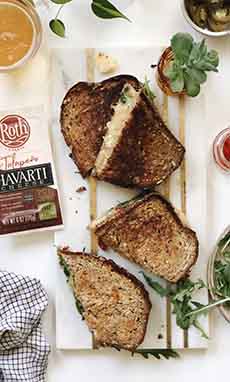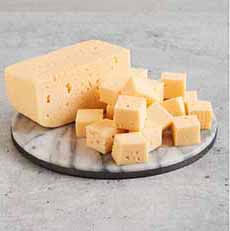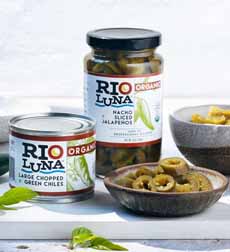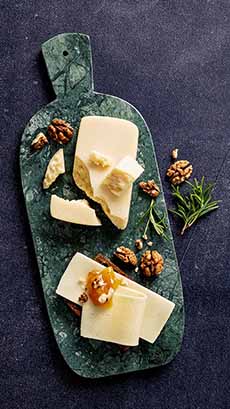The History Of Havarti Cheese & A Jalapeno Grilled Cheese Recipe With Havarti
|
|
For National Grilled Cheese Sandwich Day, April 12th, we’re adding a new sandwich to our collection of creative and delicious grilled cheese sandwiches: Jalapeño Grilled Cheese (photo #1). A bonus: the history of Havarti cheese, which is used in the sandwich. More specifically, the recipe below uses Roth’s Jalapeño Havarti Cheese (photo #2). But if you can’t find it, pepperjack is a good substitute. > The different types of cheese. > The history of Havarti cheese is below. > Also see Pairing Havarti Cheeses, below. When you need a kick of heat, this Spicy Jalapeño Grilled Cheese sandwich with creamy yet kicky Jalapeño Havarti delivers. In addition to the jalapeños in Roth Jalapeño Havarti cheese, this recipe uses jarred jalapeños (photo #5), the heat of which is tamed a bit in the jar. If you want real heat, substitute fresh jalapeños. (Whew!) This recipe was created by Bev Weidner of Bev Cooks for Roth Cheese. Check out her website for more delicious recipes. Prep time is 5 minutes, cook time is 4 to 6 minutes. 1. MELT the butter in a large skillet over medium heat. 2. LAYER half the shredded cheese on two slices of bread, followed by the pimentos, jalapeños, and a small mound of arugula. 3. PLACE the loaded bread slices in the hot pan and top with the remaining cheese. Place the two remaining slices of bread on top. Place a lid over the skillet, and grill for two minutes. 4. GENTLY FLIP and grill the sandwiches for another two to three minutes, or until the cheese has fully melted and the bread is toasty and brown. Slice and serve. This technique works for shredding semi-farm cheeses like Cheddar, Havarti, Jack, mozzarella, and others. You’ll need a box grater. 1. FREEZE the cheese for 30 minutes before grating. This keeps it firm against the box grater. 2. COAT the face of the grater with nonstick cooking spray to prevent sticking. 3. GRATE only with the side of large holes, to prevent the cheese from clumping. That should do it! Havarti is a semisoft Danish washed curd cheese, made from cow’s milk. It is interior-ripened and rindless, with small eyes (photo #3). The small “eyes” are a result of the friendly bacteria that help the cheesemaking process. It can be sliced, grilled, or melted. Havarti was previously called Danish Tilsiter after the German Tilsiter, another buttery, creamy cheese made in a town of the same name†. Modern Havarti was first produced in Denmark in 1921*. In 1952, the cheese was renamed Havarti, after Havartigården, the name of the experimental farm near Holte, on the outskirts of Copenhagen where the Danish cheese pioneer Hanne Nielsen (1829 to 1903) and her husband worked in the 19th century. (The farm still exists, as a cultural center [source].) A great cheesemaker, teacher, author, and lecturer, Nielsen created a Tilsit cheese with cumin for King Christian IX of Denmark (ruled 1863-1906). This led to her becoming “Royal Court Supplier of Dairy Products.” She was allowed to call that Tilsit “Christian IX Ost” (ost is Danish for cheese). Since “Danish Tilsiter” was renamed Havarti, this may why the creation of Havarti is attributed to her. Some sources such as The Oxford Companion to Cheese says that Nielsen invented Havarti cheese, and the Wisconsin Cheese authority agrees. The Dansk Biografisk Leksikon states that the current Havarti is not based on her cheesemaking [source]. A traditional version of Havarti originated in Denmark in the mid-1800s, delicate and creamy. Some sources say that a Danish cheesemaker experimenting with washed-curd techniques inadvertently created the cheese. Such a cheese would have been known to Nielsen, who traveled extensively to study different cheeses and cheesemaking. It may be that her cumin-accented cheese for the King was a version of this cheese. It would take more investigation than we have been able to find, to obtain further clarification. But that shouldn’t stop everyone from enjoying modern Havarti. A historical note: Hanne Nielsen won many awards from the Royal Danish Agricultural Society, but as a woman, she was not permitted to join. She tried numerous times. Havarti was finally granted PGI status (Protected Geographical Indication) in 2019 [source]. Modern Havarti has a buttery aroma and flavor; as the cheese ages, it becomes saltier and nutty. The cheese is aged anywhere from three months to two years. The longer the cheese ages, the more intensely flavorful it becomes. Havarti aged for 12 months is called Aged Havarti, and 24 months of aging creates Vintage Havarti. Aged Havarti tends to become slightly crumbly. Tiny, crunchy tyrosine crystals begin to form inside the cheese, an added treat. The cheese is now made in the U.K., Canada, and elsewhere†, and Denmark exports its Havarti. Havarti is delicious in its natural form, but it takes well to flavors. Havarti can be found in caraway, cranberry, dill, garlic, horseradish, jalapeño, and other flavors. Havarti is great for snacking, and is also popular on a sandwich or melted sandwich, a burger, or in mac and cheese or fondue. Make cheese bread and biscuits. Turn it into a cheese sauce. Go to the Wisconsin Cheese website and search for Havarti. You’ll find dozens of tempting recipes (we just made the Havarti Stuffed Pork Chop). For a cheese or charcuterie board, Havarti pairs happily with: |
|
|
________________ *According to one source, a Mr. G. Morgenthaler from Switzerland taught two dairymen at two Danish dairies how to produce this “new” cheese [source]. †Tilsit was occupied by the Red Army on January 20, 1945, and was annexed by the Soviet Union in 1945. It is now known as Sovetsk, Russia. Since then, Tilsiter-style cheeses have been produced in Switzerland and Germany, and now also in Australia, Finland, Lithuania, Poland, Romania, Russia, Ukraine, and the U.S. [source]. ‡The greatest Danish emigration occurred in 1882, when 11,618 Danes settled in the U.S. The first significant wave of Danish immigrants consisted mainly of The Church of Jesus Christ of Latter-day Saints (LDS Church) members who settled in United States in 1850 [source]. |
||








